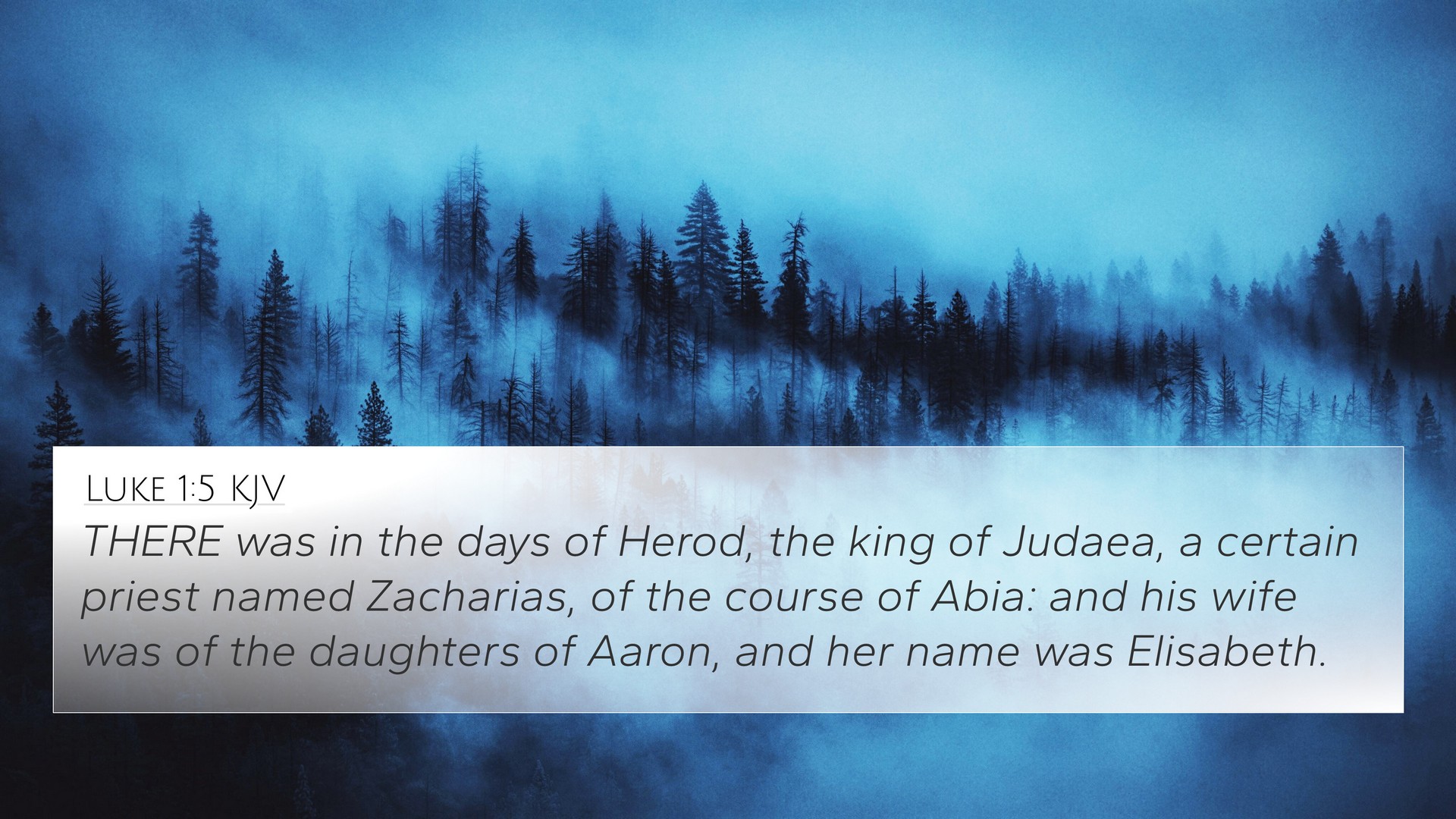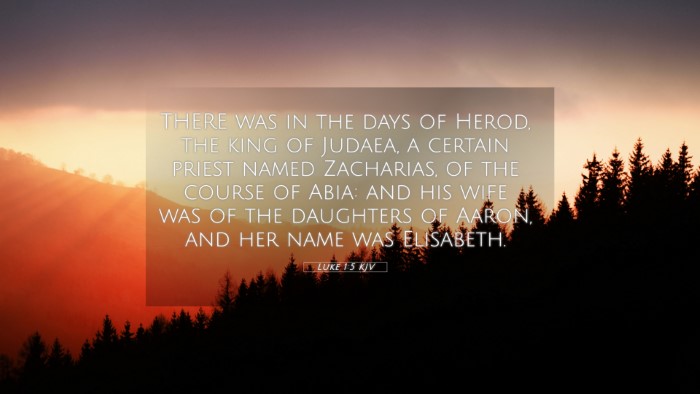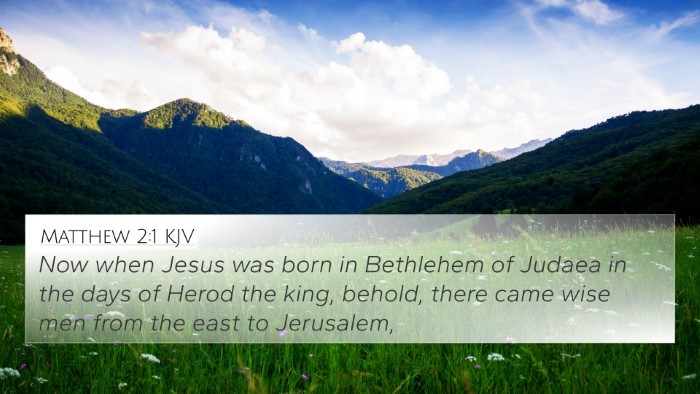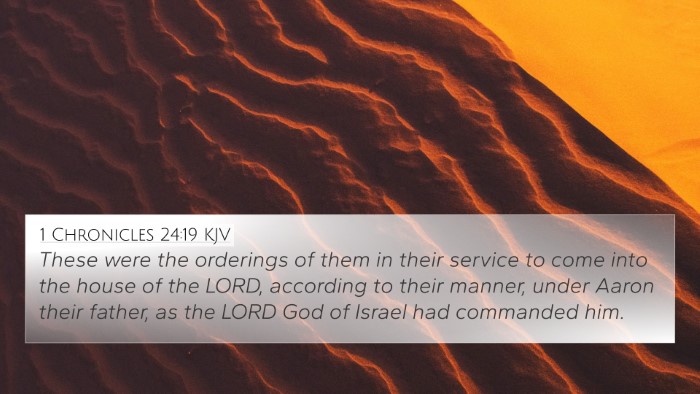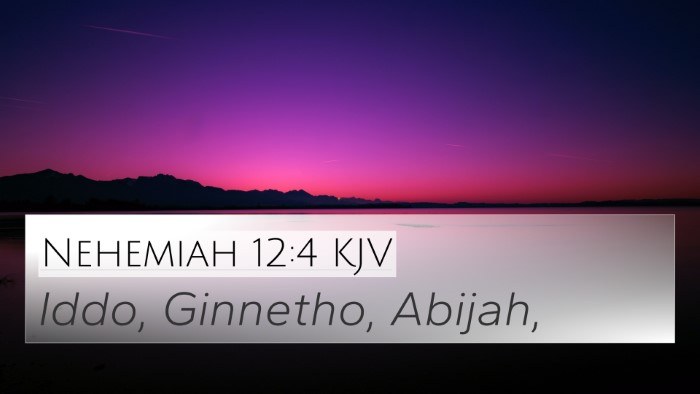Meaning and Interpretation of Luke 1:5
Luke 1:5 states: "There was in the days of Herod, the king of Judea, a certain priest named Zacharias, of the course of Abia: and his wife was of the daughters of Aaron, and her name was Elisabeth."
Contextual Analysis
In this opening verse of Luke's Gospel, we encounter a significant moment in biblical history. The narrative begins by establishing a specific historical context: "in the days of Herod". This places the events during the rule of a king notorious for his brutality.
Matthew Henry emphasizes the importance of God's choice within a time of political turmoil, where God prepares to intervene and bring forth the Messiah. The mention of Herod sets the stage for a contrast between worldly power and divine purpose.
Albert Barnes notes the relevance of Zacharias as a priest. His lineage from the course of Abia not only affirms his priestly duties but also connects to the order established in the Old Testament, as seen in 1 Chronicles 24:10, where Abijah is listed among the courses of priests.
The reference to Zacharias’s wife, Elisabeth, being of the daughters of Aaron, highlights their righteous lineage, indicating that both were from distinguished priestly families, as emphasized in Adam Clarke's commentary.
Spiritual Significance
This verse underscored the faithfulness of God, promising a miraculous event during a time filled with despair. The direct lineage to Aaron not only serves to validate Zacharias's credentials but is also a prelude to the divine announcement of their son, John the Baptist, as a forerunner to Jesus Christ.
Matthew Henry points out that the mention of their names is not merely for identification; it signifies God's intention to fulfill His promises. The faithfulness of Zacharias and Elisabeth illustrates the devotional spirit cherished in God's servants, akin to the biblical themes found in Hebrews 11:6.
Cross-References
Luke 1:5 can be linked to several important Bible verses that provide deeper dimensions for understanding this passage:
- 1 Chronicles 24:10: Details the division of the priestly course, contextualizing Zacharias's lineage.
- Isaiah 40:3: Prophetic scripture describing the calling of John the Baptist.
- Luke 1:13: The angel's announcement to Zacharias about the birth of John.
- Malachi 4:5: Prophecy about the coming of Elijah before the great and dreadful day of the Lord.
- Matthew 11:14: Jesus specifically identifies John the Baptist as the Elijah who was to come.
- Philippians 3:5: Paul mentions his heritage from the tribe of Benjamin, paralleling themes of righteousness.
- Acts 1:12: Represents the continuity of the apostles connecting with Old Testament roots.
- Hebrews 7:11-14: Discusses the priesthood established through Aaron, reinforcing the legitimacy of Zacharias's role.
- Lamentations 3:22-23: Speaks of God’s faithfulness, resonating with the context of Zacharias’s devotion.
- Luke 1:6: Further emphasizes the righteousness and blamelessness of Zacharias and Elisabeth.
Thematic Connections
The themes of divine intervention, faithfulness, and preparation permeate this verse, linking it to larger biblical narratives. The faithful lineage of Zacharias and Elisabeth connects to the overarching theme of God’s sovereignty in working through individuals and families to accomplish His redemptive purposes.
Albert Barnes explains how this narrative serves as an intersection between the Old and New Testaments, spotlighting the significance of the priesthood in God's plan. The preparation for the coming of Christ through John the Baptist represents a bridge in biblical history, demonstrating God’s consistent revelation and promise.
Conclusion
Luke 1:5 invites readers into a deeper understanding of the biblical narrative's historical and spiritual implications. Public domain commentaries like those by Matthew Henry, Albert Barnes, and Adam Clarke illustrate the layers of meaning behind this verse, revealing the faithfulness of God in preparing the way for redemption.
This verse exemplifies the connections between Bible verses, showcasing how understanding one verse can enhance comprehension of the broader scriptural themes. Cross-referencing other relevant scriptures enriches our study, offering insights not just into individual verses, but into the entire fabric of biblical teaching.
Using Cross-References for Study
To effectively study and interpret Bible verses, utilizing cross-reference tools can greatly enhance one’s understanding. Here are some tips on how to apply them:
- Bible Concordance: Utilize a concordance to find related verses and expand on themes introduced in the original verse.
- Bible Cross-Reference Guide: Utilize guides that index themes and provide connections for deeper study.
- Cross-Reference Bible Study: Engage in cross-referencing during personal or group study to foster discussion and insights.
- How to Use Cross-References: Identify key themes and follow them across the text to understand interrelated messages.
- Resources for Reference: Seek comprehensive Bible reference resources or materials that provide in-depth analysis and comparisons.
